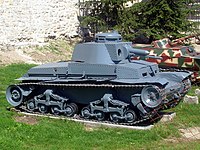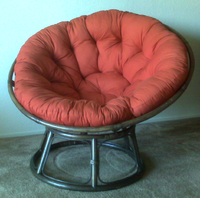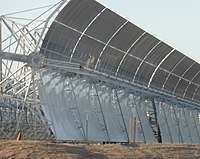Login
Our 3D CAD supplier models have been moved to 3Dfindit.com, the new visual search engine for 3D CAD, CAE & BIM models.
You can log in there with your existing account of this site.
The content remains free of charge.

Top Links
Knowledge Contributors
Search
Favorite Knowledge
Knowledge
Knowledge - 381 Items
Panzer 35(t) ( 16743 views )
Panzer 35(t)
Licensed under Creative Commons Attribution-Share Alike 3.0 (No machine-readable author provided. MoRsE assumed (based on copyright claims).).
The Panzerkampfwagen 35(t), commonly shortened to Panzer 35(t) or abbreviated as Pz.Kpfw. 35(t), was a Czechoslovak-designed light tank used mainly by Nazi Germany during World War II. The letter (t) stood for tschechisch (German: "Czech"). In Czechoslovak service, it had the formal designation Lehký tank vzor 35 (Light Tank Model 35), but was commonly referred to as the LT vz. 35 or LT-35.
A total of 434 were built; of these, the Germans seized 244 when they occupied Bohemia-Moravia in March 1939 and the Slovaks acquired 52 when they declared independence from Czechoslovakia at the same time. Others were exported to Bulgaria and Romania. In German service, it saw combat during the early years of World War II, notably the invasion of Poland, the Battle of France and the invasion of the Soviet Union before being retired or sold off in 1942. It was used for the remainder of the war by other countries and as a training tank in Bulgaria into the 1950s.
Panzergewinde ( 13962 views )
Panzergewinde
The Stahlpanzerrohrgewinde standard for screw threads, more often called by the shorter name Panzergewinde (pronunciation), was a technical standard created in Germany and subsequently used in various countries, such as the German-speaking world (Germany, Switzerland, Austria) and neighboring European countries. It has been retracted. The German name "Stahlpanzerrohrgewinde" translates to English as 'steel (pipe armoured) conduit thread'. The thread is used to join pieces of electrical conduit and cable glands.
Alternative stylings of the German name are Stahl-Panzer-Rohr-Gewinde and an abbreviated form, StaPa-Rohr-Gewinde.
The standard, codified by the Deutsches Institut für Normung (DIN, German Institute for Standardization), is DIN 40430. Panzergewinde sizes are named with the prefix PG plus a nominal number which approximately corresponds to the maximum cable diameter (in millimeters) that can be passed through the conduit.
Because the walls of the conduit are usually relatively thin, the thread depth is limited. Thus a thread angle of 80° is used. The Verband der Elektrotechnik, Elektronik und Informationstechnik (VDE) (which began as a trade association for standardization in electrical engineering) originally standardized (and named) the thread for use with conduit and cable glands that were made of steel, although today the thread is used with both steel (typically plated with combinations of nickel, zinc, or tin to resist rusting) and polyvinyl chloride (PVC).
Beginning in 2000, the VDE standard for cable glands (VDE 0619) was formally replaced by EN 50262. After a transitional period of several years during which it could still be used, it was replaced in 2003 by a final metric fine thread with 1.5 mm (0.0591 in) pitch. Similarly, conduit threads were replaced by EN 60423.
Even today, Panzergewinde cable glands are still often found on chemical reactors and bioreactors (for example, PG13.5 thread for screwing in sensors) and various other equipment, enclosures, junction boxes, and connectors.
Papasan chair ( 5327 views )
Papasan chair
A papasan chair (also called a bowl chair or moon chair) is a large rounded bowl-shaped chair with an adjustable angle similar to that of a futon. The bowl rests in an upright frame traditionally made of rattan, but also sometimes made of sturdy wicker or wood. The papasan chair gained popularity when American World War II servicemembers brought them home from Asia, where they had been used in the Philippines and Japan for centuries.
The cushion of the chair is typically thick velveteen material filled with cotton fluff. In traditional papasans, the cushion can be removed and used outside of the sturdy frame, although it is hand-wash only.
The mamasan chair is a double-seating version, and was introduced to the western world in the 1950s. Prior to that it was in use in far eastern Asia, particularly in Indonesia, Thailand and Japan. It can also be called as double papasan chair which is widely used.
Papasan chairs are typically 35–60 inches wide and 35 inches deep.
Paper clip ( 13606 views )
Paper clip
A paper clip (or sometimes paperclip) is an instrument used to hold sheets of paper together, usually made of steel wire bent to a looped shape. Most paper clips are variations of the Gem type introduced in the 1890s or earlier, characterized by the almost two full loops made by the wire. Common to paper clips proper is their utilization of torsion and elasticity in the wire, and friction between wire and paper. When a moderate number of sheets are inserted between the two "tongues" of the clip, the tongues will be forced apart and cause torsion in the bend of the wire to grip the sheets together.
Parabolic antenna ( 20272 views )
Parabolic antenna
A parabolic antenna is an antenna that uses a parabolic reflector, a curved surface with the cross-sectional shape of a parabola, to direct the radio waves. The most common form is shaped like a dish and is popularly called a dish antenna or parabolic dish. The main advantage of a parabolic antenna is that it has high directivity. It functions similarly to a searchlight or flashlight reflector to direct the radio waves in a narrow beam, or receive radio waves from one particular direction only. Parabolic antennas have some of the highest gains, meaning that they can produce the narrowest beamwidths, of any antenna type. In order to achieve narrow beamwidths, the parabolic reflector must be much larger than the wavelength of the radio waves used, so parabolic antennas are used in the high frequency part of the radio spectrum, at UHF and microwave (SHF) frequencies, at which the wavelengths are small enough that conveniently-sized reflectors can be used.
Parabolic antennas are used as high-gain antennas for point-to-point communications, in applications such as microwave relay links that carry telephone and television signals between nearby cities, wireless WAN/LAN links for data communications, satellite communications and spacecraft communication antennas. They are also used in radio telescopes.
The other large use of parabolic antennas is for radar antennas, in which there is a need to transmit a narrow beam of radio waves to locate objects like ships, airplanes, and guided missiles, and often for weather detection. With the advent of home satellite television receivers, parabolic antennas have become a common feature of the landscapes of modern countries.
The parabolic antenna was invented by German physicist Heinrich Hertz during his discovery of radio waves in 1887. He used cylindrical parabolic reflectors with spark-excited dipole antennas at their focus for both transmitting and receiving during his historic experiments.
Parabolic trough ( 15853 views )
Parabolic trough
Licensed under Creative Commons Attribution-Share Alike 3.0 (Z22).
A parabolic trough is a type of solar thermal collector that is straight in one dimension and curved as a parabola in the other two, lined with a polished metal mirror. The sunlight which enters the mirror parallel to its plane of symmetry is focused along the focal line, where objects are positioned that are intended to be heated. For example, food may be placed at the focal line of a trough, which causes the food to be cooked when the trough is aimed so the Sun is in its plane of symmetry. Further information on the use of parabolic troughs for cooking can be found in the article about solar cookers.
For other purposes, there is often a tube, frequently a Dewar tube, which runs the length of the trough at its focal line. The mirror is oriented so that sunlight which it reflects is concentrated on the tube, which contains a fluid which is heated to a high temperature by the energy of the sunlight. The hot fluid can be used for many purposes. Often, it is piped to a heat engine, which uses the heat energy to drive machinery or to generate electricity. This solar energy collector is the most common and best known type of parabolic trough. The paragraphs below therefore concentrate on this type.
Parachute ( 14024 views )
Parachute
A parachute is a device used to slow the motion of an object through an atmosphere by creating drag (or in the case of ram-air parachutes, aerodynamic lift). Parachutes are usually made out of light, strong fabric, originally silk, now most commonly nylon. They are typically dome-shaped, but vary, with rectangles, inverted domes, and others found. A variety of loads are attached to parachutes, including people, food, equipment, space capsules, and bombs.
A drogue chute is used to aid horizontal deceleration of a vehicle such as fixed-wing aircraft and drag racer); provide stability, as to certain types of light aircraft in distress, tandem free-fall; and as a pilot triggering deployment a larger parachute.
Parachuting ( 17164 views )
Parachuting
Parachuting is a method of transiting from a high point to Earth with the aid of gravity, involving the control of speed during the descent with the use of a parachute or parachutes. It may involve more or less free-falling (the skydiving segment) which is a period when the parachute has not yet been deployed and the body gradually accelerates to terminal velocity.
Parade ( 11435 views )
Parade
Licensed under Creative Commons Attribution 2.0 (Ian Gampon from NYC, USA).
A parade (also called march or marchpast) is a procession of people, usually organized along a street, often in costume, and often accompanied by marching bands, floats, or sometimes large balloons. Parades are held for a wide range of reasons, but are usually celebrations of some kind. In Britain, the term parade is usually reserved for either military parades or other occasions where participants march in formation; for celebratory occasions, the word procession is more usual. In the Canadian Forces, the term also has several less formal connotations.Protest demonstrations can also take the form of a parade, but such cases are usually referred to as a march instead.
Parallel axis theorem ( 48558 views )
Parallel axis theorem
In physics, the parallel axis theorem, also known as Huygens–Steiner theorem, or just as Steiner's theorem, after Christiaan Huygens and Jakob Steiner, can be used to determine the mass moment of inertia or the second moment of area of a rigid body about any axis, given the body's moment of inertia about a parallel axis through the object's center of gravity and the perpendicular distance between the axes.


















